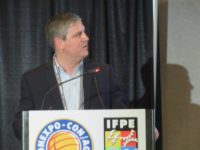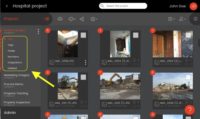...or AI, reaches decisions by rapidly navigating alternative paths, discarding the less optimal and moving forward. However, in the 1980s, there was not enough processing power to take AI to its full potential.
Computers are much more capable now, though, particularly the very powerful ones that can be accessed over broadband connections at hosted centers. Also more powerful are the algorithms supporting the optimization processes.
Scientists now are referring to optimizing solutions as “evolutionary computing,” and in site design, the goal boils down to finding a way to achieve as close to a balanced site as possible, given the developer’s goals and constraints, and establish the finished floor elevation, or FFE. To reach that, SITEOPS systematically considers layers of interlocking decisions, with alternatives weighed against goals and constraints and millions of possibilities set aside in favor of increasingly more successful solutions.
Christopher Roberts, a project engineer with Little Diversified Architectural Consulting, Charlotte, is a committed user. He says Little embraced the product last August when BLUERIDGE moved from a per-acre price to the annual subscription pricing model; the firm now uses it on every project.
The tool quickly can analyze multiple alternative sites to come up with development costs for site selection, he says. It can also show clients the least costly approach and run alternative costs for moving elements or raising floor elevations.
But it is the software’s ability to resolve difficult problems and deliver direct savings to clients that puts dollars in the till.
At a Siemen’s Energy plant in Charlotte, Roberts was challenged to find a FFE for a new building, along with parking for employees and retention ponds for drainage that could handle the current and future project plans. The job had challenges, though. The 90-acre site was studded with huge rock outcroppings that could triple excavation costs per-yd. The ramp connecting the new building to the existing one had to comply with Americans With Disabilities Act regulations.
Roberts was able to enter constraints to redline some of the outcroppings, which the firm had decided to work around. By changing the floor elevation, the team optimized and priced several scenarios to present to the owner within one week.
“We were able to fix the finish floor at 40 ft away, 60 ft away and 100 ft away, and grade out the site so it would balance, and show the owner six scenarios for the earthwork and cost,” Roberts says.
“The 60-ft-out and three-ft-lower plan was generally the most cost-effective grading and haul-off numbers,” Roberts says. He estimates Siemens saved about $100,000 in site costs over alternatives.
“It’s like playing chess against a computer, says Detwiler. “The reason the computer beats you every time is the human mind can only look about six moves ahead, while the computer is looking from now to the end of the game. There are millions of ways to lay out a site, grade a site, drain a site, and SITEOPS is looking at all the possibilities and looking at which options are better.”
“In a matter of hours, it’s looking at millions of possibilities. In the end it says, ‘Here’s your best option,’ with a CAD drawing and a budget—and it took me only two hours instead of two weeks,” Detwiler says.
Bentley says he sees the advantages. “Each time we look at it, the results seem to be about $15,000 more advantageous [for] choosing one of the SITEOPS solutions as opposed to what we came up with looking at it, even with our best folks,” says Bentley. “It’s simulation toward optimization of the site design concept.”
Bentley says he sees great potential in applying the approach with more advanced input data. He would like to see SITEOPS interface with other sophisticated software programs, such as stormwater modeling.
Bentley concludes, “Anything that proves the premise like this shows there is a lot more we can do. Evolutionary computing is going to be creeping into all aspects of it.”








Post a comment to this article
Report Abusive Comment